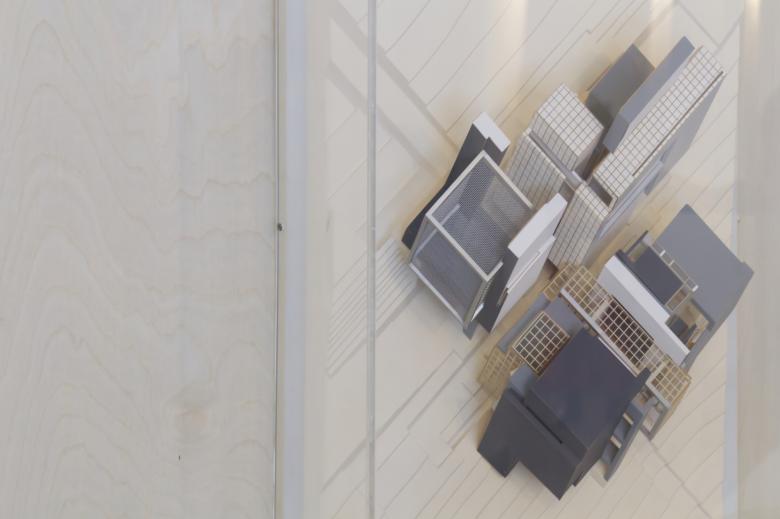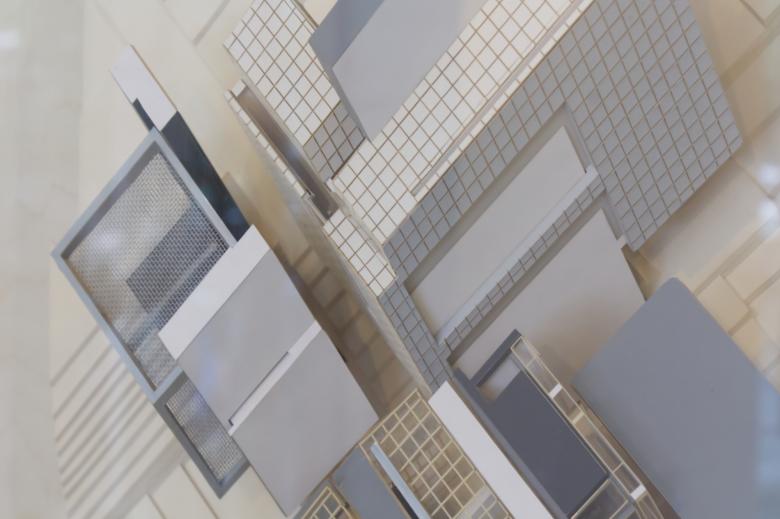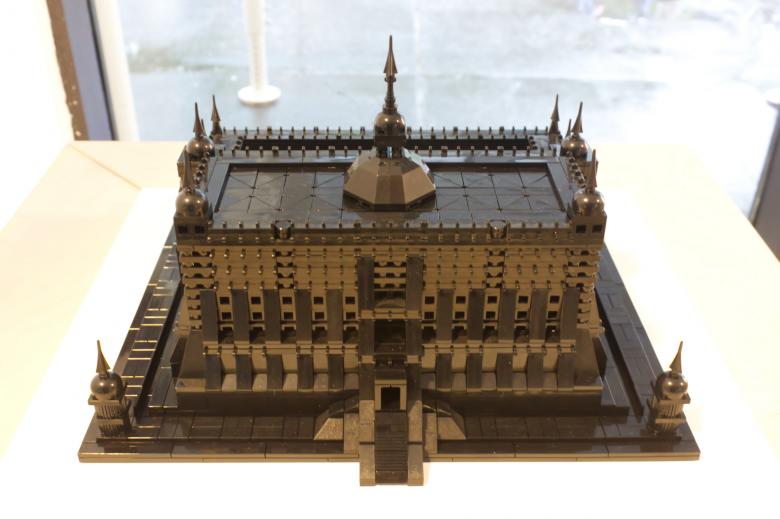Architects Modeling New Behaviors at Cooper Union
Staging Form (2022) by Studio Sean Canty (All photographs by John Hill/World-Architects)
Model Behavior is an exhibition of models — architectural and otherwise — on display at The Cooper Union's Irwin S. Chanin School of Architecture in New York City. Curated by Anyone Corporation, the exhibition of 55 models asserts that there is "an urgency for architecture to model new behaviors, for itself and for the world."
If the name Model Behavior sounds familiar, that is because the exhibition that opened on October 4th shares its name with the theme for the 50th issue of Log, released in the fall of 2020. Editor Cynthia Davidson, the head of Anyone Corporation and curator of the exhibition with Patrick Templeton, wrote at the beginning of Log 50: "All around us today, cultural, scientific, and historical models are being called into question." Pertaining to architecture, "the carbon-based models of habitation that architecture has essentially produced since the Industrial Revolution" is one source of change, as is "a profession historically 'modeled' by white males," among others.
Although the connection between the earlier issue of Log and the new exhibition is not explicit in the literature for the latter, the exhibition similarly looks to wider fields, "placing architectural models among models from other disciplines, including science, mathematics, and popular culture." The 55 contributions are diverse in form, media, and message, with some of them requiring work to be understood, as the curators attest, some inviting interaction, and others seeking to inform. Off-the-shelf pieces, like a Swiss railway clock ("a model of the relationship between the Sun and the Earth") and a mannequin, sit alongside models out of films, architectural proposals, and research projects, among other types of models.
On my opening-day visit to the exhibition in the colonnade of Cooper Union's Foundation Building, I ended up training my camera on models more overtly architectural than not, finding a lot to appreciate in the diversity of contributions. Below are a few highlights, in order of their appearance in the building's lobby and colonnade.


Fraudacre City (2017) by Hector Design sits in the lobby of the Foundation building as one of the first models that visitors to the exhibition encounter.
Similar to Fraudacre City's collage of colorful elements is Supertall Superobject: Proposal for Collective Living IV (2022) by Office Kovacs.
Instead of sprawling across the landscape, the aptly named Supertall Superobject is "a conceptual model for collective living in the form of a vertical conglomerate," per the exhibition literature.
More bold colors are on display in Best Sandwiches (2016) by Jennifer Bonner/MALL, a "design and research project in search of novel stacks."
At first glance Barn Raising (2022) by Besler & Sons looks simply like a well-crafted depiction of some fairly unexceptional wood-frame construction.
But looking at the various objects up close (here looking through the window from the sidewalk) reveals how Barn Raising is made primarily of paper, with many of the tools actually about the process of making the model rather than the making of the building it depicts.
Models and Mis-behaviors: Architectures of Democracy (2022) by Höweler + Yoon is a multimedia display, with models accompanied by videos, drawings, and even a handout. Passersby on the sidewalk can gain a glimpse of the models through the window.
The models in Models and Mis-behaviors survey the different types of organization and seating in spaces of democratic assembly, while the video shows how politicians and rioters have acted unruly within those spaces.
The small models of Imperfection (2022) by BairBalliet are actually pieces of a game that "references the shifting building codes that encourage densification and single-family neighborhoods with the construction of accessory dwelling units (ADUs)."
A few of the contributions directly engage the sidewalk outside the colonnade, including Interim Urbanism: Youth, Dwelling, City (2019) by N H D M Architects.
The vertical drawing and horizontal models of Interim Urbanism "present a set of typological and formal excerpts of the architecture of tentative 'homes' [...] occupied by the youth in New York City."
An ongoing research project,
Interim Urbanism was previously exhibited at the 2019 Seoul Biennale of Architecture and Urbanism.
The most famous architectural model in the exhibition is certainly House X (1975) by Eisenman Architects, a complex and puzzling model that looks like an axonometric drawing.
House X is not entirely unexpected in an exhibition curated by Cynthia Davidson, who has been married to Peter Eisenman since 1990. Behind glass, it looks like a museum piece among the other objects on display.
A Sacred Place (2019) by Ekow Nimako is a futuristic reimagining of the Great Mosque of Djenné in Mali, echoing the artist's
Kumbi Saleh 3020 CE that we learned about last year.
At the far end of the colonnade is Olana Orchard Studio Architectural Model (2019) by SAA/Stan Allen Architect, which is comprised of a film projector and what appears to be a massing model when seen from the sidewalk.
Seen from inside the colonnade, SAA's Olana Orchard Studio proposal for the Olana historic site in the Hudson River Valley is actually a large cutaway model.
The interior of the outside projection for Olana Orchard Studio depicts the view the artist occupying the studio would see if the project were realized.
Model Behavior is on display at The Cooper Union's Foundation Building (7 East 7th Street, New York City) until November 18, 2022. Visitors are required to show proof of vaccine and identification to access the exhibition, though parts of it can be seen from the sidewalk.
In tandem with the exhibition, the School of Architecture will present two Great Hall lectures:



















